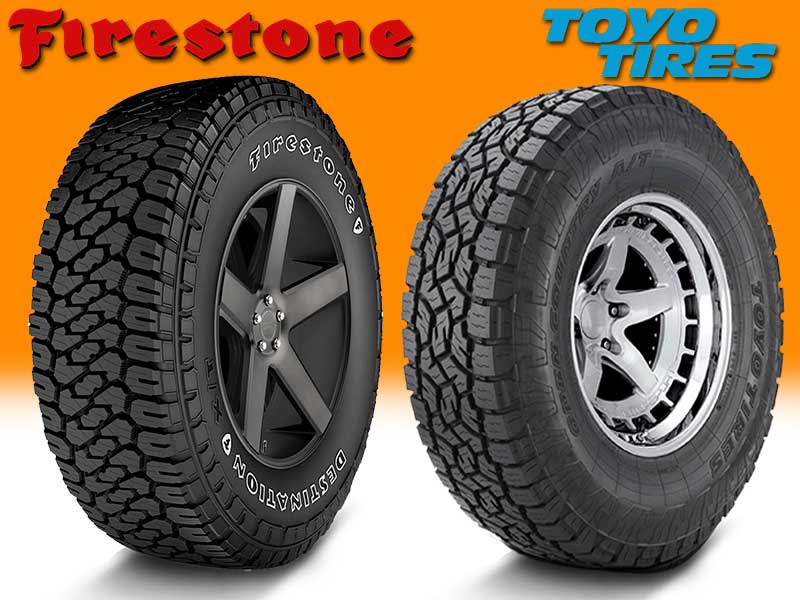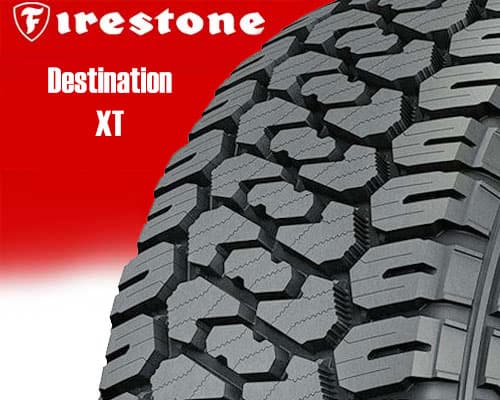Firestone Destination XT vs Toyo Open Country AT3: The Firestone Destination XT features a very unique design with a combination of saw-toothed texture on the longitudinal edges and deep open slots on their outer margins, supplying you with epic grip on a variety of surfaces. But how would this tire perform next to Toyo Open Country AT3? Well we are about to find out.
But first, let’s check out the available sizes on both tires.

Examine the treads on these tires closely. They hold the key to knowing which to choose. In fact if you visit my "tread design" page, picking the right tire would never bother you.
| Dimensions | Firestone XT | Toyo AT3 |
|---|---|---|
| Wheel Diameter | 15 to 20 inches | 15 to 22 inches |
| Speed Ratings | R and S | Q, R, S, T, H |
| Load Ratings | C and E | C to F |
| Weight Range | 35 to 60 lbs | 30 to 72 lbs |
| Tread Depth | 14 to 17/32″ | 12.7 to 17/32″ |
| Warranty | 50k miles | 65k miles |
Table of Contents
Tread Design

- Destination XT shows a rugged look characterizing three rows of multi-edged, independent blocks with prominent lateral and longitudinal spaces among them.
- The central blocks are C and S-shaped and their edges are saw-toothed, providing an enhanced biting ability. These ribs are formed in an overlapping manner, making wavy circumferential grooves between them. Plus, the blocks of the middle rib have lateral notches which further improve the biting efficiency.
- Its tread specifies a dual siping pattern as the central blocks have zigzag sipes and the shoulder lugs are marked by multiple linear sipes.
- Shoulder blocks have relatively less aggressive inner edges but they do have open slots and staggering on the outer margin.
- Its sidewall lugs are also large and strengthened, hence, providing lateral stability and improved gravel traction.
- The carcass of this tire is multilayered and sturdy. It has a two-ply structure of polyester cords over the twin steel belts with a 1-ply nylon cord reinforcement. Hence, it has a 3-ply tread overall.
On the other side, the Toyo Open Country AT3 features a similar structural pattern, though with very different features.

- Toyo AT3 features bigger S shaped lugs, surrounded by F shaped ones (in the middle).
- All these lugs have solid reinforced foundations unlike the Firestone XT.
- Though they form similar interconnected web of grooves, and features only rectilinear siping.
- The shoulder lugs are the biggest on the tread, and are separated by the central lugs with the help of wider circumferential grooves.
- The shoulder lugs although features decent lateral tread voids, they are still very packed up, as those gaps have connectors in between.
- Moreover, all these lugs also sit on continuous running rubber layer underneath, which provide supports during cornering.
- These lugs also join up together, making sidewall lugs, though those could use some rubber, as they are not thick enough.
Dry Traction
Dry traction can be broken down into two primary components, namely directional and lateral grip.
Directional grip is calculated with braking efficacy, and here, the tread’s middle section is what to look out for (as it makes the most contact with the road while rolling straight).
So it makes sense why both tires offering equal footprint from there supply with such similar performance values.
Though still in terms of cornering, which is a bigger factor of overall dry traction, the Toyo Open Country AT3 is taking the lead, mainly because of it’s superior stability.
Like mentioned in the tread section, the tire features stiffer rubber compound, and all its lugs have solid supports underneath them. This allows for firmer contact with the ground.
Whereas on the other hand, the Destination X/T suffers from stability issues, with its lugs flexing excessively due to its large tread depth and softer composition. Moreover, the tire also does not features ridges placed between the shoulder lugs either, further compromising on maneuvering stability.
(So it makes sense why the Toyo AT3 comes out with better speed ratings in comparison).
Wet Performance
Wet performance can be understood with two things: wet grip and hydroplaning resistance.
The wet grip is dependent on the stiffness of the (tread) compound as well as the sipes. And in this regard, the Firestone Destination X/T, with its higher silica density, that results in a softer tread build, outperforms its counterpart.
Basically, sipes work by flexing to create a vacuum, so that they could effectively soak water particles into their slits and clear off the surface. So with softer rubber compound, they get to have a better efficacy to do so.
On the other side the Toyo AT3 lacks, not only due to it’s stiffer compound, but with limited number of sipes as well.
Though the tire with similar looking interlocking tread voids supply you with good enough float speeds on both curved and straight aqua tests.
But still overall, Firestone X/T has the upper hand here. Though its wet traction, while comparing with other A/T options, is still not that commendable after all.
Fuel Consumption
Fuel consumption is heavily influenced by rolling resistance, which is indirectly related to factors such as weight, tread depth, and composition.
Having said that, despite both tires having similar tread depths, the Toyo Open Country AT3 with it’s greater overall weight (almost 10 lbs heavier), causes some issues for it in the fuel department.
With greater weight, its lugs bear more pressure on them, as the rub off the surface, and this accounts for greater rolling resistance generation.
And so as a result, you see great fuel consumption with this tire, compared to Firestone Destination X/T.
Tread Life
Tread life is although also dependent on rolling resistance, there are other things to look out for.
That’s why it makes sense why Toyo AT3 with larger resistance, still manages to provide you with longer tread life.
The tire comes out with stiffer rubber compound, so the burning rate of its tread is lower. And it also features deeper tread voids, which means it would take longer for it to reach down to replacement levels.
The Firestone Destination XT does the opposite. Its rubber is softer, and tread depth is shallower.
Though the difference is only marginal. That’s why in terms of warranties, the Toyo AT3 gives out only 5k more miles.
Winter Performance
While both tires are 3 peak mountain snowflake rated, the Firestone Destination X/T takes the lead due to its specialized snow biters, known as “snow vices”, along with slots on the shoulder lugs.
Both of these features work in harmony, to provide snow to snow contact.
Basically on snow, you need minimum rubber exposure, that’s why skinnier tires do so great here.
And Firestone Destination X/T with greater number of biters, supply superior snow holding abilities, which then allows for lodged snow to effectively meetup with the ground.
Moreover, unlike the Toyo AT3, the tire also features a compound with superior thermal adaptability. So it’s bitter remain flexible even with freezing temperatures.
Tread Noise
Tread noise is essentially the result of air particles colliding with the (tread) rubber, creating unwanted sound waves.
And this air mostly comes in, form the shoulder voids/gaps.
That’s why the Toyo AT3 with connectors/ridges there, gets to be quieter overall. Those ridges basically restrict air’s flow, killing noise at the source.
In comparison, the Destination X/T is not missing with this features, but its softer compound also is more reflecting of the generated noise.
So it produces a lot more in-groove resonance as well.
Gravel Road Traction
Driving on gravel poses the risk of stones getting lodged in the tire’s tread, and that then not only causes problems in the traction department, but you get your tread damaged.
Though both tires with cut resistant rubber compounds, don’t have that issue. But still with superior self-cleaning abilities, the Firestone Destination X/T supplies you with better handling and braking abilities, overall.
Performance on Mud
In muddy conditions, there are two main things which makes a tire great. It having, self cleaning abilities, and paddles.
And considering both it can be explained why the Firestone X/T comes out with more appreciable results.
The tire for one, is slightly more voided up, and it’s shoulder blocks don’t have any hurdles in between them. This allows for superior mud cleaning form its tread.
Moreover, its shoulder lugs with slots and staggered edges provide better throwing of the thick mud backwards, which as a result generates superior forward momentum.
Though the major point is still self cleaning here. And Toyo AT3 with such closed up shoulders, don’t allow mud to leave out, especially sideways.
Rocky Terrain Traction
When climbing rocks, you need durability along with biters. And here both tires have their good and bad.
When it comes to Toyo Open Country AT3, the tire features decent biters, and notches facing in all directions. These supply you with grip form all angles, allowing for greater lateral and longitudinal traction.
Though as the tire is heavier, you get lacking performance on incline traction tests.
Moreover, with the tire’s stiffer compound and thinner sidewall lugs, you don’t get as much traction efficacy, with lowered air pressure, as the Destination X/T.
Though Firestone X/T really lacks when it comes to lateral traction with its missing biters on the shoulder lugs.
Summing Up
In summary, the Toyo Open Country AT3 demonstrates superior performance in dry conditions, in terms of grip, handling and steering response.
That’s why it makes sense why the tire comes out with speed ratings up to H.
Though its wet traction could really use some help, as its stiffer compound, don’t let its sipes to effectively breath water off.
Though that’s not the case with Firestone Destination X/T, where it’s ample sipes not only excels in wet conditions, you also get superior snow traction as well, despite both tires coming with 3 peak mountain snowflake ratings.
And although this tire also supplies you with a more fuel efficient design, its overall tread life still takes the back seat to Toyo AT3.
